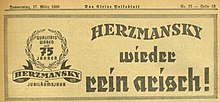
Back Arisierung ALS Арыянізацыя Byelorussian Арыянізацыя BE-X-OLD Ариизация Bulgarian Arianització Catalan Arizace Czech Arisierung German Arianización Spanish آریاییسازی Persian Aryanisation French

Aryanization (German: Arisierung) was the Nazi term for the seizure of property from Jews and its transfer to non-Jews, and the forced expulsion of Jews from economic life in Nazi Germany, Axis-aligned states, and their occupied territories. It entailed the transfer of Jewish property into "Aryan" or non-Jewish hands.
"Aryanization" is, according to Kreutzmüller and Zaltin in Dispossession: Plundering German Jewry, 1933-1953, "a Nazi slogan that was used to camouflage theft and its political consequences."[1]
The process started in 1933 in Nazi Germany with transfers of Jewish property and ended with the Holocaust.[2][3] Two phases have generally been identified: a first phase in which the theft from Jewish victims was concealed under a veneer of legality, and a second phase, in which property was more openly confiscated. In both cases, Aryanization corresponded to Nazi policy and was defined, supported, and enforced by Germany's legal and financial bureaucracy.[4][5][6][7][8]
Michael Bazyler wrote that the Holocaust was "both the greatest murder and the greatest theft in history". Between $230 and $320 billion (in 2005 US dollars) was stolen from Jews across Europe,[9] with hundreds of thousands of businesses Aryanized.[10]
- ^ Kreutzmüller, Christoph; Zatlin, Jonathan (2020). Dispossession: Plundering German Jewry, 1933-1953. Ann Arbor, MI: University of Michigan Press. doi:10.3998/mpub.9315192. ISBN 978-0-472-13203-4. S2CID 240613308.
- ^ Bopf, Britta (2004). "Arisierung" in Köln: Die wirtschaftliche Existenzvernichtung der Juden 1933-1945. Cologne: Emons Verlag Köln. ISBN 389705311X. Archived from the original on 2017-12-01. Retrieved 2017-12-01.
- ^ Shoah Resource Center. "Aryanization" (PDF). Yad Vashem. Yad Vashem. Retrieved 1 December 2017.
- ^ "Confiscation of Jewish Property in Europe, 1933–1945 New Sources and Perspectives Symposium Proceedings" (PDF). UNITED STATES HOLOCAUST MEMORIAL MUSEUM CENTER FOR ADVANCED HOLOCAUST STUDIES. 2003. Archived from the original (PDF) on 2 December 2017. Retrieved 2 December 2017.
Particularly impressive and equally disturbing is the robbers' effort to ensure that property confiscation was carried out by "legal" means through a vast array of institutions and organizations set up for this purpose. The immensely bureaucratic nature of the confiscation process emerges from the vast archival trail that has survived. Arguments that no one knew about the Jews' fate become untenable once it is clear how many people were involved in processing their property. "Legal" measures often masked theft, but blatant robbery and extortion through intimidation and physical assault were also commonplace.
- ^ Döblin, Alfred (28 November 2010). "Plünderung jüdischen Eigentums Billigende Inkaufnahme "Wie Deutsche ihre jüdischen Mitbürger verwerteten": Die Enteignung der Juden ist gut dokumentiert. Wolfgang Dreßen hat die Akten gesichtet". Die Tageszeitung: Taz. Retrieved 2 December 2017.
- ^ Kieser, Albrecht (February 15, 2006). "Späte Enthüllungen An der Aufklärung über Arisierungen ist man in Deutschland noch immer nicht sonderlich interessiert". Telopolis. Heise Online. Archived from the original on December 2, 2017. Retrieved 2 December 2017.
- ^ "Das Finanzamt Moabit-West "verwertete" das Hab und Gut jüdischer Opfer des Nationalsozialismus". Berline Woche. Berline Woche. 18 January 2017. Retrieved 2 December 2017.
- ^ ""Arisierung" in Köln". Portal Rheinische Geschichte. Landschaftsverband Rheinland. Archived from the original on 20 March 2018. Retrieved 2 December 2017.
- ^ Bazyler, Michael J. (2005). Holocaust Justice: The Battle for Restitution in America's Courts. NYU Press. p. xi. ISBN 978-0-8147-2938-0.
- ^ Gotz., Aly (2016). Hitler's beneficiaries. Verso Books. ISBN 978-1-78478-634-2. OCLC 946605582.
© MMXXIII Rich X Search. We shall prevail. All rights reserved. Rich X Search